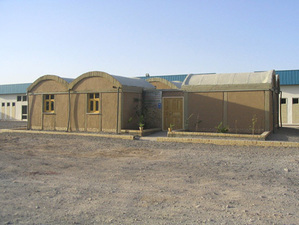Objectives

The Bam earthquake of December 26, 2003 killed 26,000 people and injured a further 40,000. 70% of the buildings were destroyed, including the earthen citadel of Arg-è Bam. In a matter of seconds, the city became a vast field of ruins, an open-air catalog of construction defects demonstrating the human cause of the disaster. The local geophysical characteristics (faults, alluvial deposits) and those of the earthquake were disastrous for this vulnerable city.
Take the time to fully understand to position the intervention
Following a diagnosis of the situation based on national and international expertise, recommendations were made to help define a strategy for safeguarding the cultural landscape. The Bam Declaration, issued at the International Workshop in April 2004, set out the guiding principles for any intervention: "to preserve the full significance of Arg-è Bam and its environment", "to safeguard the character and heritage of the city and its landscape" and "to integrate heritage into the reconstruction process".
Taking a step back to learn lessons and avoid repeating mistakes
No building material is earthquake-proof. It's knowing how to build that saves structures and lives. While industrial materials benefit from a universal scientific basis, "local materials" can rely on accumulated "tried and tested" knowledge. In Bam, however, the low frequency of earthquakes, which allows lessons to be learned, has prevented the development of this knowledge.
An integrated approach but slow results
CRAterre and its partners have proposed to revitalize the earthen industry around three complementary axes: materials, heritage and habitat. This approach encourages and supports the development of socio-economic activities that capitalize on the region's resources and strengths. In the space of just a few months, a number of activities have been carried out: studies and diagnostics, testing and fine-tuning of materials and construction elements, installation of a laboratory and production line, design and construction of housing prototypes, reconstruction of the citadel's Second Gate, training courses for professionals and staff from ICHHTO, NDRII and IHF. These activities have contributed to significant progress and acceptance of earth materials. Despite this, dozens of families who had chosen the earthquake-resistant earthen housing prototype validated by the Iranian authorities were unable to obtain it.
Anticipate and prepare
Due to resistance that is more a matter of "ignorance", it is virtually impossible to rapidly implement solutions using local materials when these have not been validated before the disaster. Once the emergency phase is over, impoverished populations no longer have access to unaffordable, over-sophisticated industrial materials. The exclusion of local materials increases the vulnerability of those in the majority who have no choice but to turn to local solutions, which are also better suited to environmental, economic and cultural considerations. Introducing local development upstream is the surest way to reduce risks.
Results
- post-disaster diagnosis ;
- setting up a production unit and analysis laboratory;
- 2 earthquake-resistant prototypes;
- mason training ;
- raising awareness among decision-makers and players in the construction industry ;
- contribution to the drafting of the Bam declaration.
Partners
Iranian Cultural Heritage, Handicrafts and Tourism Organization (ICHHTO), Bam City Council, Iranian Research Center for the Conservation of Cultural Relics (RCCCR), Islamic Housing Foundation (IHF), Iranian Natural Disasters Research Institute (NDRII), University of Yazd (Iran), Ministère de la Culture et de la Communication (France), Ministère des Affaires Etrangers (France), UNESCO, United Nations Development Programme (UNDP), Fondation de France, Misereor, Conseil Général de l'Isère (CG38).



